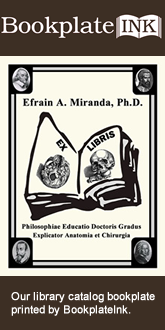Open letter to friends and colleagues:
I started "Medical Terminology Daily" in October 2012, hosted at my own website, which has been online since 1998. The objective of "Medical Terminology Daily" is to be a service to the medical community, medical students, medical industry, and public in general. We post a workweek daily medical, anatomical, or surgical term, its meaning and usage, as well as biographical notes on anatomists, surgeons, and researchers through the ages. This last content stays for a week on the sidebar called "A Moment in History" and after a week, it is published as a main body article.
Each week we send a newsletter with a week's worth of articles to those who have subscribed. An example of the newsletter can be seen here.
Initially, I thought this site to be mostly about Clinical Anatomy and Medical Terminology, but the trends of the requests and conversations have created articles on Histology, Pathology, Surgical Procedures and Techniques, History of Surgery, etc. This has taxed me and the few contributors we have.
After almost two years the traffic is very good and now I am looking to expand the group of contributors to the site. I could not do it before because we lacked a good submission system for the articles. We are now in the final beta testing stage for the submission system.
We are looking to add ten new contributors to the website from different venues in Medical Sciences, including physicians, surgeons, anatomists, and university professors in Basic Medical Sciences. Preferably, all contributors should have graduate and postgraduate studies. Although we do appreciate the interest of students and the public in general, we want to maintain a very high level of professionalism and credibility. If you yourself cannot be a contributor, you may know someone who would qualify. Feel free to forward this letter as needed by clicking on the envelope icon at the top of this article.
I am sure that everybody is busy, but even small contributions are most welcome. Contributors can use the material in this website for their own teaching purposes: all we ask is proper credit where it is due.
If you want to consider participating, first please look at the footer of the "Medical Terminology Daily" website. at In this footer are the links to the pages that we offer our contributors as well as the guidelines for publication, and the link to access the backend of the website and write an article directly.
Each contributor can do as much or as little as they want, and we offer a page so that you can post a biography, or links to your website. We have one contributor (not listed yet) that is planning to present this website to his students and have them work on article ideas, so they learn to research as well as to write properly. His plan is to select the three best articles in his class and submit them for publication. The publication of the article with recognition to the author will be another item on the student's CV!
If you want to apply as a contributor, please send a message using the "Contact Us" page in this website with information on your studies, place of work, and how to contact you back. I promise to answer all of the requests. Those who are accepted as contributors will receive their login information as well as a manual to manage the back end of the website.
Your consideration is most appreciated
Sincerely,



